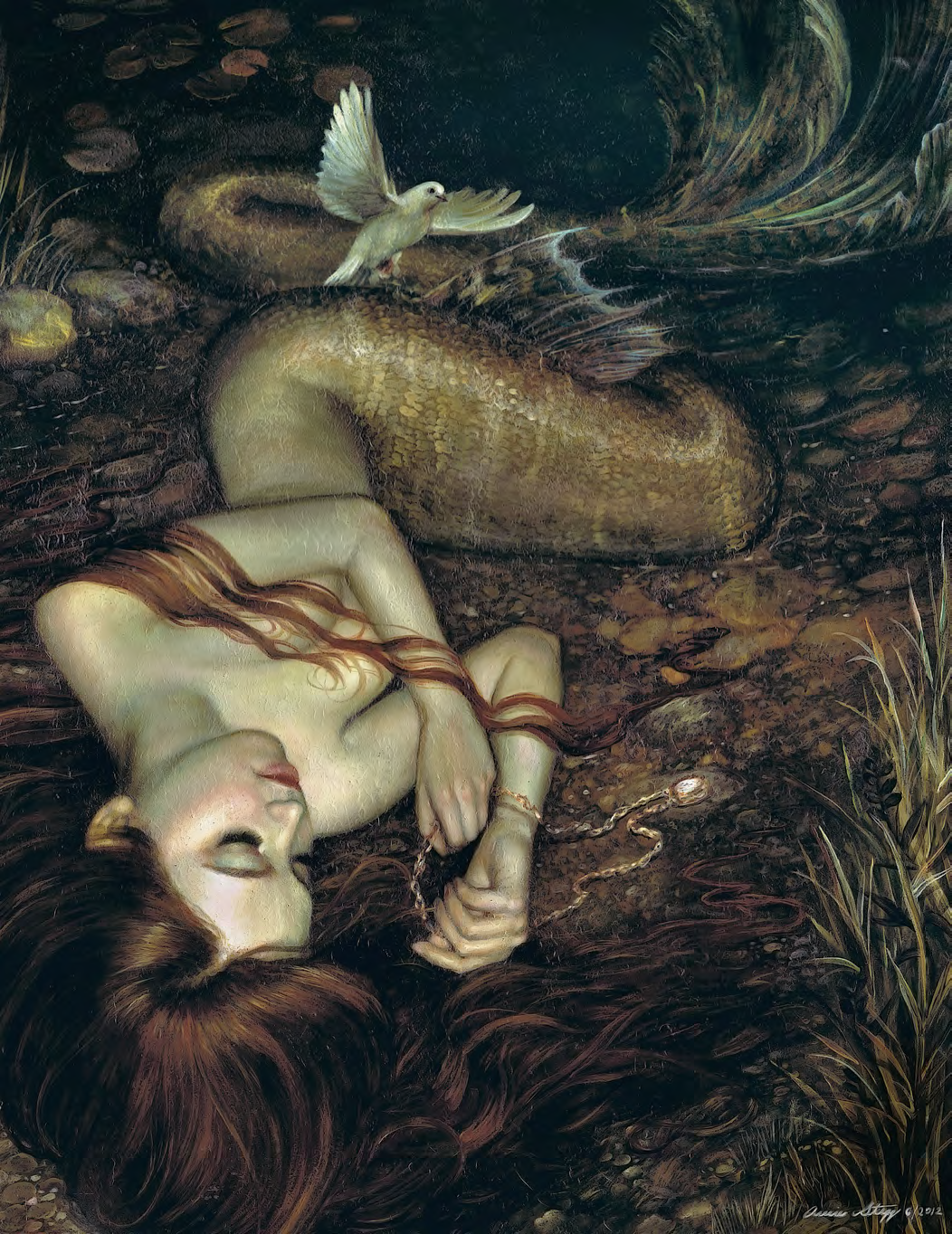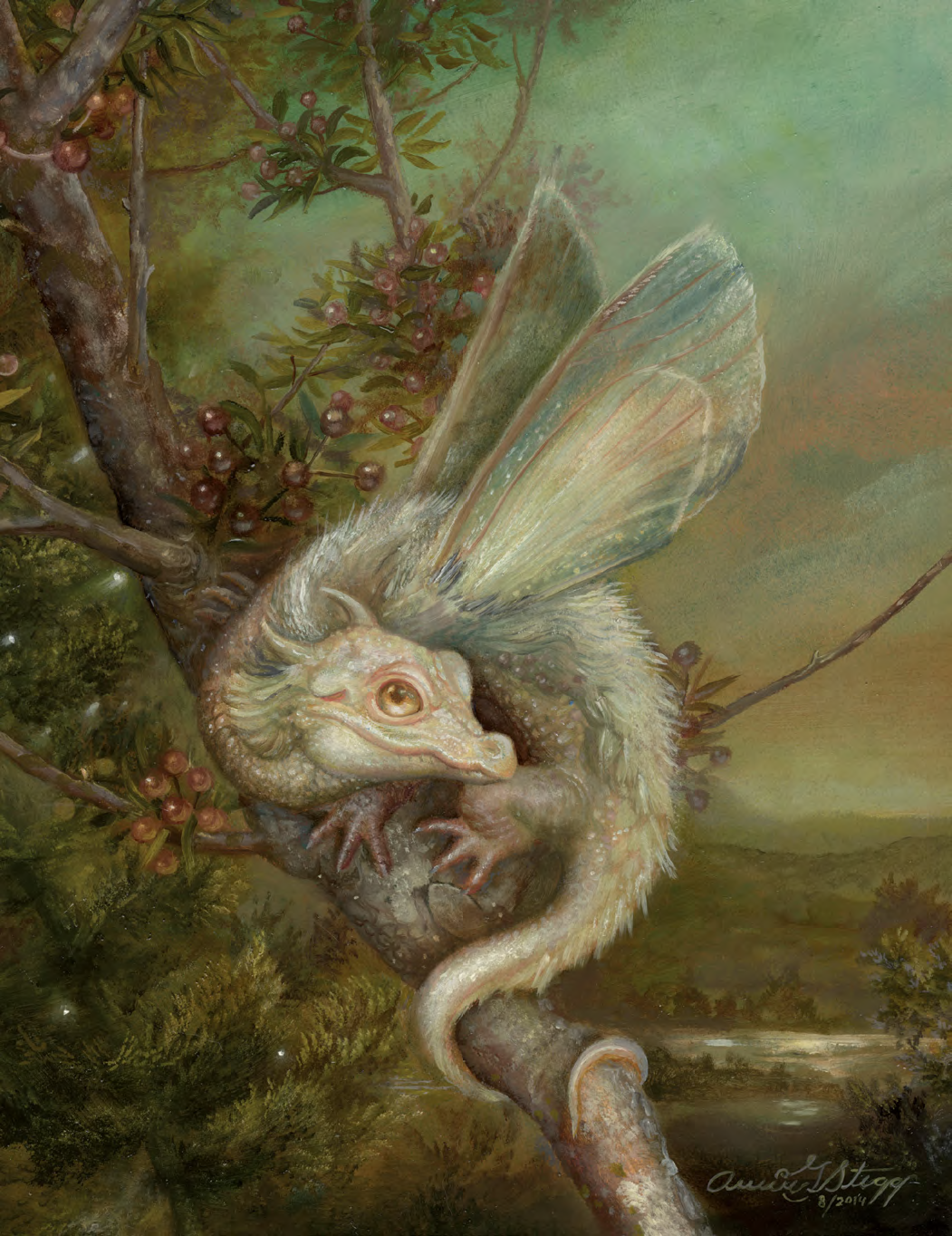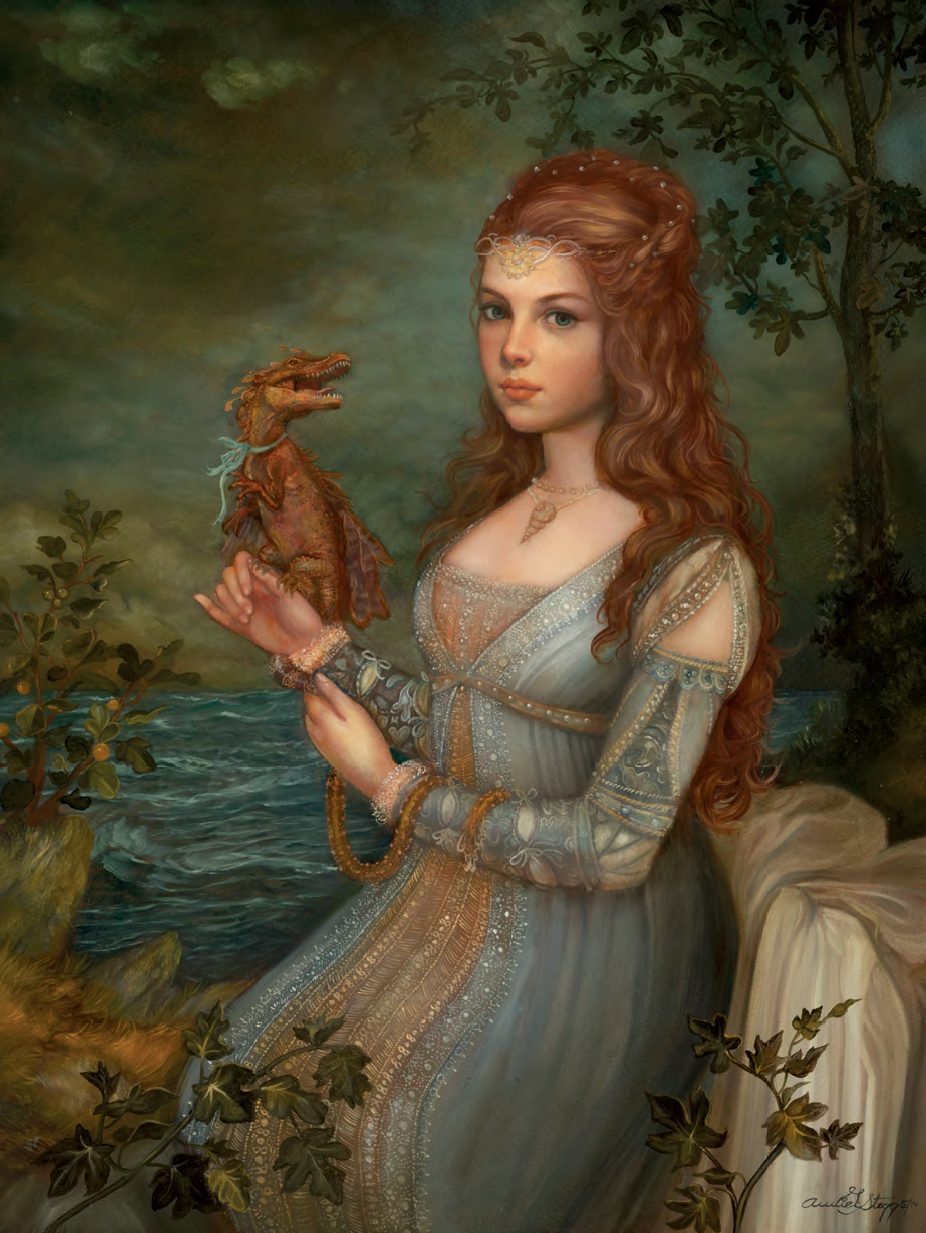A dragon-like sea monster rears above a ship, terrifying in its unleashed rage, yet beautiful—delicate scales, a sinuous grace to its form.
A maiden cautiously steps into a fairy ring, her garments diaphanous, her expression concerned. Around her, fées, elves, and animals of the forest—each as clear as a photograph—look on watchfully.
To enter Annie Stegg’s world is, like her maiden, to enter a world of enchantment. It is a universe populated with dragons and gnomes, flying horses and mermaids. And always powerful, intriguing women. Says Stegg, “Women have borne, nurtured, and raised every great figure the world has ever known. Women’s story, however commonplace-seeming when seen against the backdrop of great kings and terrible wars and the rise and fall of nations, deserves to be heard in all its humanity, beauty, tenderness, and strength.” However, Stegg’s vision of feminine power is expansive. “I don’t think you have to play up women as superheroes who go around fighting giants and killing bad guys to show them as strong. I think that sort of thinking is a trap that well-intentioned but misguided men have laid for women. They establish that strength in combat is the chief virtue, and then they throw a bone to women as if to say, ‘See, women can be cool too!’—if they are tough warriors in the masculine mold. But this is to deny that there is so much more depth to our humanity and that women have something unique and wonderful to contribute to our story.”
These are lovely images, no question—Stegg combines the whimsical delicacy and sepia palette of Arthur Rackham with a rococo lushness. She cites Fragonard and Boucher’s oil paintings as inspirations, as well as the Pre-Raphaelites. But this world is not a safe one. A hint of darkness is always hidden just beyond the sightline.
An artist from her earliest years, Stegg, who lives in Georgia, was drawn from childhood to fairy tales, folklore, and the nature of her native South. “Mythology has always fascinated me,” she says. “On the one hand it shows our common lives thrown against the dramatic and timeless backdrop of gods and angels, heaven and eternity. It gives us a glimpse into people from another time in a world that is often magical yet still not unlike our own. We get to see what the hopes and fears were for the people of that place and time, and by comparison, we can examine our own lives so that we can see what is mere superficiality and what is integral to our humanity.
“On the other hand these are the stories that defined our early human culture. They are some of the most classic of tales, from a time before books and television, when people had to pass down oral stories from generation to generation as a means to impart wisdom from one generation to the next. I find that we as humans aren’t really so different from those people, and so I think there is a lot to be gleaned from mythology.”

After graduating from the Art Institute of Atlanta with a degree in fine arts in 2004, Stegg began working in a range of media, including acrylics, oils, and watercolor. She does not just paint figures; she designs complete universes of fully realized characters—sometimes literally: Stegg is in demand as a character and story designer for gaming and publishing clients. Meanwhile, fittingly, in her work and the courses she teaches, Stegg combines traditional methods with the new visual opportunities afforded by digital technology. The results are at once modern and timeless.
She and her husband Justin—a frequent collaborator—work from home. Her studio is a light-filled sunroom overlooking a forest and a garden filled with mossy boulders, ferns, and flowers. Says Stegg, “There are lots of little places for birds, toads, and lizards to make homes. So when I work I am mostly seeing the leaves swaying in the background, which is an ideal environment for the type of work I like to do.” (She is now working on a painting of a frog prince.)
Stegg is inspired by well-known stories, but she looks beneath the surface. Long captured by the bittersweet story of Thumbelina, she cites one particular passage of Hans Christian Andersen’s:
During the whole summer poor little Tiny lived quite alone in the wide forest. She wove herself a bed with blades of grass and hung it up under a broad leaf, to protect herself from the rain. She sucked the honey from the flowers for food and drank the dew from their leaves every morning. So passed away the summer and the autumn, and then came the winter—the long, cold winter. All the birds who had sung to her so sweetly were flown away, and the trees and the flowers had withered.
This passage led Stegg to wonder about Thumbelina’s life, and to her series Thumbelina and the Four Seasons. “I couldn’t help but imagine all the adventures Thumbelina had on her own living in the forest—how a world that we know so well could become so different if we were miniature like her. How would she handle everyday problems? What creatures could she befriend? What places would she visit?” Her Thumbelina lives in a world of imagination—imperious, beruffled toads, regal songbirds—yet her constant vigilance, the sense of powers beyond her control, are ever present.

In her Daughters of Oceanus series, Stegg again extends her protection to young women. Taking her inspiration from Greco-Roman mythology, Stegg portrays the water spirits—daughters of Okeanos and Tethys who not merely looked after Earth’s water but after maidens. Each of her characters—the dignified Styx, the lovelorn Klytie, the direct Lilaia—is a fully realized personality, her mythological beginnings only the beginning of her ever-expanding story.
Women in Mythology expands her influences to include the lore of many cultures: In this series, Stegg portrays the Syrian Atargatis—said by some to be the original mermaid—as well as the siren of Greek mythology and Blodeuwedd the Welsh owl maiden. And as with so many of her works, Stegg brings a sweet subversion to her re-imaginings. Her Leda is gently partnered with a swan, her medieval maiden carefully cradles a unicorn—not to entrap but to safeguard the creature. As she explains, “I wanted to illustrate an instance where someone didn’t want to give the unicorn to its captor and instead hid it to keep it safe, preserving the innocence of both involved.”

Then there are the more contemporary influences. Her portrait of Daenerys Targaryen shows us the Game of Thrones character as mythological being, as timeless as one of Stegg’s classical subjects. The Mother of Dragons lies on a divan, for all the world like a Venus—but her hand is extended to an alert, adolescent dragon that, even pale and serene, hints at leashed violence.
A painting of Odysseus menaced by the sea monster Scylla and the angry whirlpool Charybdis is genuinely terrifying. Even here, however, the focus is on the angered and transformed nymphs, once beautiful, now monstrous. There is an inner life, a deeper interest, the well-known mythology merely the beginning of Stegg’s universe.
And always there is the backdrop of the natural world—alive, secret, captured with a naturalist’s eye and a poet’s sensibility. Her dragons, for instance, have the detail and delicacy of a paleontologist’s rendering, but the components—head, fangs, scales, tail, watchful eyes—are a product of her imagination, an imagination as inspired by the natural as it is by the enchanted. Says Stegg, “There are so many little dramas and tiny miracles going on all around us all the time. No matter what interesting fiction we might come up with in our imaginations, the actual world around us seems to always have something even more fascinating and inspiring happening in it, if we only take time to look.”

































